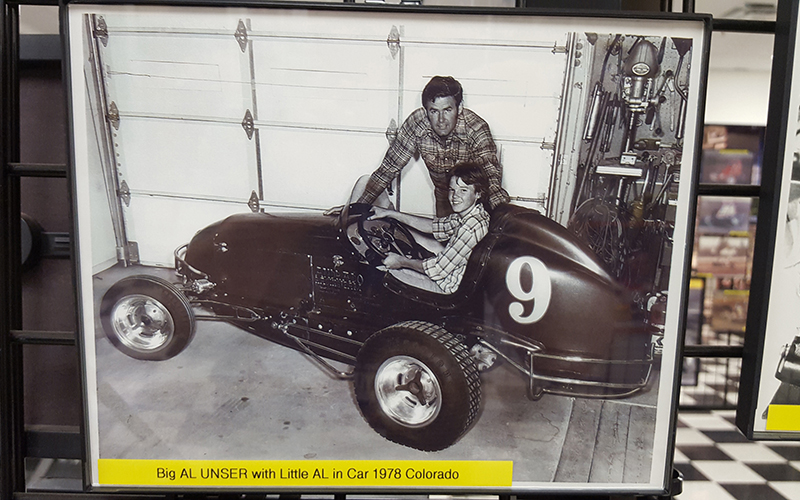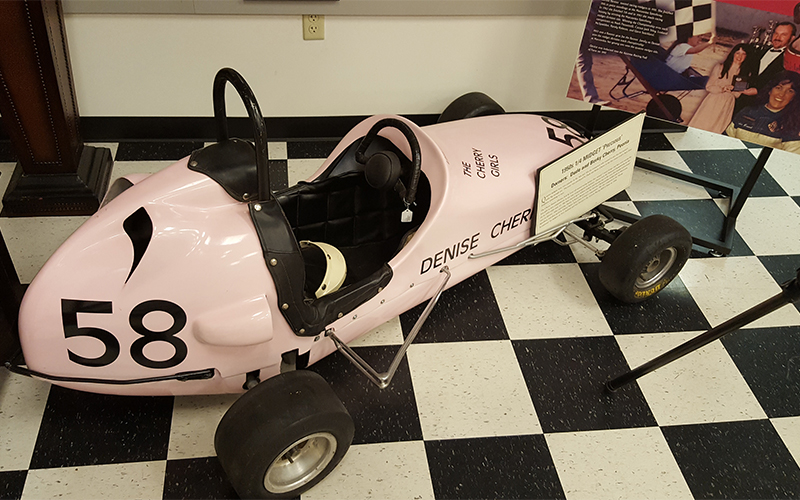
A photo of the Unser family hangs on the wall of the Arizona Open Wheel Racing Museum. (Photo by Tyler Rubin/Cronkite News)

A 1950s quarter midget located in the Arizona Open Wheel Racing Museum. (Photo by Tyler Rubin/Cronkite News)

Steve Stroud was a sponsor of Kyle Larson during his sprint car days. (Photo by Tyler Rubin/Cronkite News)
PHOENIX – There is a lot of racing history packed within the walls of the Arizona Open Wheel Racing Museum in east Phoenix, and it all started as a gimmick that a local businessman cooked up to draw racing fans into his stores.
“A gentleman named Steve Stroud, a local business owner, came to me and wanted to display some cars in the lobbies of his local stores,” said Mickey Meyer, director of operations for the museum.
“At first he didn’t realize how much exposure it would bring him and how many people would come in just to look at the cars and leave.”
Stroud, 66, recently passed away after a battle with cancer, but his legacy lives on in the 15,000-square-foot facility that houses memorabilia and race cars from dirt tracks where many of the country’s best drivers learned their craft.
The museum houses thousands of items. There are more than 25 race cars including a 1933 sprint car and another car owned and driven by Al Unser. There are hundreds of photos, including some of several current NASCAR drivers from their sprint car days.
The Bobby Ball Memorial Cup, a trophy to the annual winner of the Bobby Ball Memorial Race at the Arizona Fairgrounds, is housed there. Winners featured on the trophy include four-time Indianapolis 500 winner A.J. Foyt and Phoenix-born racing hero Jimmy Bryan, who won the 1958 Indy 500 before dying two years later at 33 from injuries sustained in a crash.
“We’ve got some, frankly, priceless memorabilia and artifacts here in addition to some of the cars that were a fixture in the Arizona racing scene and even the national racing scene,” said Keith Watkins, adviser to the board of directors at the museum.
The museum is a fitting memorial for Stroud, too.
“It was hard,” Watkins said of Stroud’s death. “I didn’t know him very long, but he was such a gentle person and a kind person that I think everybody he met had an affection toward him.”
Rickey Hood, curator at the museum, agreed.
“I didn’t know him like the other people here. I didn’t know him as long,” Hood said. “He made such an impact on my life in such a quick time. He was just a special person, and I was blessed to have met him before he perished.”
Many items have a personal impact for families of the racing legends who visit the museum.
“This has brought so many families together, people who haven’t seen each other in decades, people who are reliving memories of their grandparents,” said Meyer. “They open books in here and see pictures of their fathers racing, when before they only heard stories. I’ve seen people look at pictures and just start crying.”
Stroud started the museum in 2011, and it had outgrown the 1,200-square-FOOT shop Stroud and Meyer planned for it before they even had it open.
“I don’t think we even had the papers written up yet and we had expanded to the back, which was supposed to be storage for his normal business,” Meyer said.
Stroud, who grew up in Southern California, was described as a true fan of racing. When he moved to Arizona in the late 1970s, he fell in love with Manzanita Speedway, a popular dirt track located in southwest Phoenix that closed in 2009.
“He was just a sweet man,” said Hood, the curator. “I tell you what, not a better person anywhere in the world. He loved motorsports, loved racing, loved people in general, helped a lot of racers.”
Stroud was the owner of Lubrication Equipment & Supply and several ParkerStore Hose & Fitting locations, which helped him become more than just a fan. In the 1990s, Stroud reached into his own pockets to sponsor a racing team. Among his drivers was current NASCAR driver Kyle Larson.
Meyer met Stroud through Stroud’s sponsorship of local driver Bob Ream. Meyer was Ream’s crew chief.
Meyer also was a driver at one time, and he and his father have items and photos featured in the museum. When the museum started, Meyer helped restore the cars and Stroud tracked down the parts to do it.
Hood, from Memphis, Tennessee, came to his curator role after years of racing. He was a three-time U.S. Auto Club Champion and a 2006 inductee into the National Sprint Car Hall of Fame.
When Hood relocated to Arizona, Stroud invited him to help with the museum.
“It still gave me a way to be involved in motorsports and stay with something I grew up around,” Hood said.
Watkins, who also has a driving background, started out as a volunteer at the museum. Now, he, Meyer and Hood are building on what Stroud started.
And the future is bright, although the three have run into a familiar problem once again.
“We’re out of space,” Watkins said. “We need to expand. We’re looking for a new home.”
Editor’s Note: A previous version of this story incorrectly stated the size of the facility. It is 15,000 square feet.